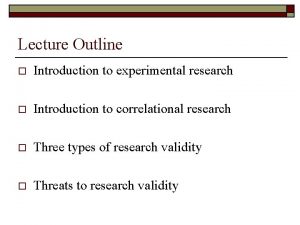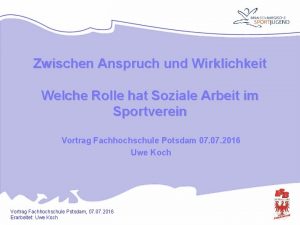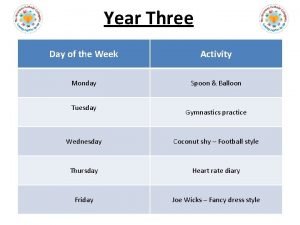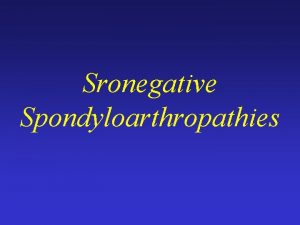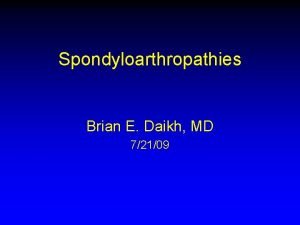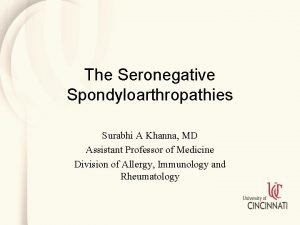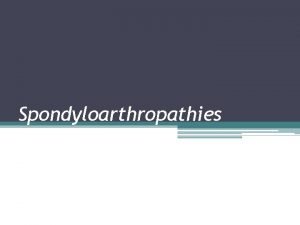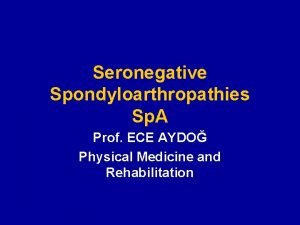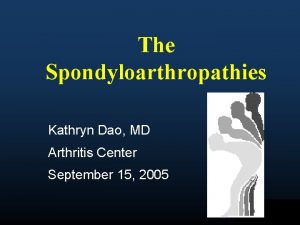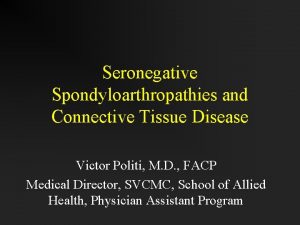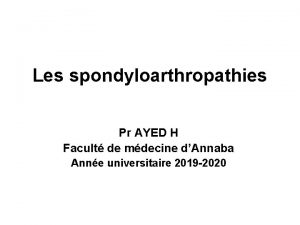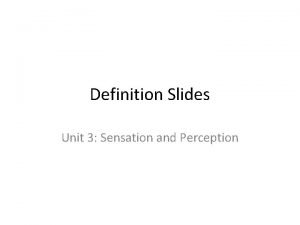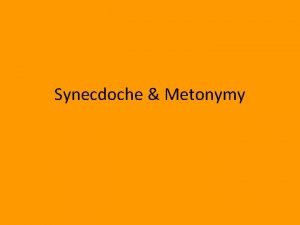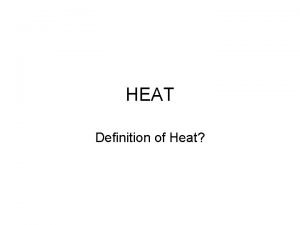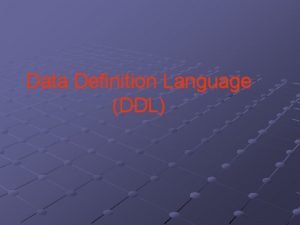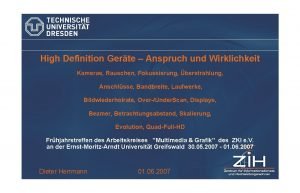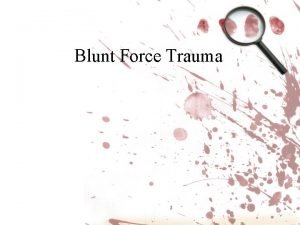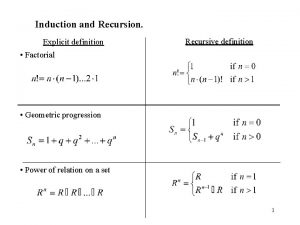Sronegative Spondyloarthropathies 1 Definition The spondyloarthropathies are a





















































- Slides: 53

Sronegative Spondyloarthropathies 1

Definition • The spondyloarthropathies are a group of disorders that share certain clinical features and an association with the HLA -B 27 allele 2

Sronegative Spondyloarthropathies • • • 3 Ankylosing spondylitis(AS( Reiter's syndrome, reactive arthritis Psoriatic arthritis Enteropathic arthritis and spondylitis Juvenile-onset spondyloarthropathy Undifferentiated spondyloarthropathy

4

Ankylosing Spondylitis • Ankylosing spondylitis (AS) is an inflammatory disorder of unknown cause that primarily affects the axial skeleton; peripheral joints and extraarticular structures may also be involved 5

Ankylosing Spondylitis • Primary AS • Secondary: IBD Reactive Arthritis Psoriatic Arthritis 6

EPIDEMIOLOGY • Prevalence: less than 0. 01% • Usually begins in the second or third decade • The prevalence in men is approximately three times that in women • Striking correlation with the histocompatibility antigen HLA-B 27 • The general prevalence of B 27 is 7% • over 90% of patients with AS have inherited this antigen • The association with B 27 is independent of disease severity. 7

EPIDEMIOLOGY • 1 to 6% of adults inheriting B 27 have been found to have AS • In families of patients with AS, the prevalence is 10 to 30% among adult firstdegree relatives inheriting B 27 • Concordance rate in identical twins is estimated to exceed 65% 8

PATHOLOGY • The enthesis, the site of ligamentous attachment to bone, is thought to be the primary site of pathology in AS, particularly in the lesions around the pelvis and spine. • Enthesitis is associated with prominent edema of the adjacent bone marrow and is often characterized by erosive lesions that eventually undergo ossification. 9

10

11

PATHOLOGY • Sacroiliitis is usually one of the earliest manifestations of AS • The early lesions consist of subchondral granulation tissue containing lymphocytes, plasma cells, mast cells, macrophages, and chondrocytes; infiltrates of lymphocytes and macrophages in ligamentous and periosteal zones; and subchondral bone marrow edema. 12

Pseudo-Widening of Right SI Joint 13

PATHOLOGY • The irregularly eroded, sclerotic margins of the joint are gradually replaced by fibrocartilage regeneration and then by ossification. Ultimately, the joint may be totally obliterated 14

15

16

17

18

PATHOLOGY • • spine inflammatory granulation tissue at the junction of the annulus fibrosus the margin of vertebral bone. • The outer annular fibers are eroded and eventually replaced by bone, called a syndesmophyte, • then grows by continued enchondral ossification, ultimately bridging the adjacent vertebral bodies • . Ascending progression of this process leads to the "bamboo spine" observed radiographically 19

PATHOLOGY • Spine • Other lesions in the spine include diffuse osteoporosis, erosion of vertebral bodies at the disk margin, "squaring" of vertebrae, and inflammation and destruction of the disk-bone border. Inflammatory arthritis of the apophyseal joints is common, with erosion of cartilage by pannus, often followed by bony ankylosis. 20

PATHOLOGY • Peripheral Joints synovial hyperplasia, lymphoid infiltration, and pannus formation, but the process lacks the exuberant synovial villi, fibrin deposits, ulcers, and accumulations of plasma cells seen in rheumatoid arthritis 21

PATHOGENESIS • • • 22 Incompletely understood HLA-B 27 Immune-mediated Enteric bacteria may play a role. Elevated serum titers of antibodies to certain enteric bacteria, particularly Klebsiella pneumoniae, are common

23

Clinical Features of AS Skeletal Axial arthritis (eg, sacroiliitis and spondylitis) Arthritis of ‘girdle joints’ (hips and shoulders) Peripheral arthritis uncommon Others: enthesitis, osteoporosis, vertebral, fractures, spondylodiscitis, pseudoarthrosis Extraskeletal Acute anterior uveitis Cardiovascular involvement Pulmonary involvement Cauda equina syndrome Enteric mucosal lesions Amyloidosis, miscellaneous 24

CLINICAL MANIFESTATIONS • Late adolescence or early adulthood • The median age in western countries is 23 • In 5% of patients, symptoms begin after age 40 • The initial symptom is usually dull pain, insidious in onset, felt deep in the lower lumbar or gluteal region, accompanied by low-back morning stiffness of up to a few hours' duration that improves with activity and returns following periods of inactivity 25

CLINICAL MANIFESTATIONS • Within a few months of onset, the pain has usually become persistent and bilateral. Nocturnal exacerbation of pain that forces the patient to rise and move around may be frequent. 26

27

CLINICAL MANIFESTATIONS • Enthesopathy iliac crests, greater trochanters, ischial tuberosities, tibial tubercles, and heels 28

CLINICAL MANIFESTATIONS • Peripheral joints • Hips and shoulders ("root" joints) occurs in 25 to 35% of patients • Arthritis of peripheral joints other than the hips and shoulders, usually asymmetric, occurs in up to 30% of patients and can occur at any stage of the disease. 29

Extraarticular manifestation • Constitutional symptoms • Acute anterior uveitis • Aortic insufficiency, 30

extraarticular manifestation • Eye 31

extraarticular manifestation • Heart Aortic insufficiency Congestive heart failure Third-degree heart block 32

extraarticular manifestation • Lung 33

Apical Fibrosis 34

extraarticular manifestation • Nervous system: Cauda equina syndrome 35

physical findings • loss of spinal mobility 36

physical findings • The Schober tes 37

38

physical findings • sacroiliac joints tenderness 39

physical findings • Chest expansion 40

course • Extremely variable • Typical severe untreated case • The patient's posture undergoes characteristic changes • The disease in women tends to progress less frequently to total spinal ankylosis, • Increased prevalence of isolated cervical ankylosis and peripheral arthritis in women • The most serious complication of the spinal disease is spinal fracture 41

42

43

44

LABORATORY FINDINGS • • 45 HLA-B 27 ESR CRP Anemia

Ankylosing Spondylitis • Radiographic findings include: – Sclerosis of the sacroiliac joints – Pseudo-widening of the sacroiliac joints due to erosive changes – Fusion of the sacroiliac joints – Bamboo spine 46

RADIOGRAPHIC FINDINGS • sacroiliitis 47

48

Pseudo-Widening of Right SI Joint 49

Fusion of Bilateral Sacroiliiac Joints 50

51

Modified New York Criteria for the Diagnosis of AS • Clinical Criteria – Low back pain, > 3 months, improved by exercise, not relieved by rest – Limitation of lumbar spine motion, sagittal and frontal planes – Limitation of chest expansion relative to normal values for age and sex 52 • Radiologic Criteria – Sacroiliitis grade 2 bilaterally or grade 3 – 4 unilaterally

Treatment • • • 53 Exercise NSAIDs(Indomethacin 150 mg) Sulfasalazine MTX Corticosteroids Biologic agents
 Insidan region jh
Insidan region jh Hình ảnh bộ gõ cơ thể búng tay
Hình ảnh bộ gõ cơ thể búng tay Lp html
Lp html Bổ thể
Bổ thể Tỉ lệ cơ thể trẻ em
Tỉ lệ cơ thể trẻ em Gấu đi như thế nào
Gấu đi như thế nào Glasgow thang điểm
Glasgow thang điểm Alleluia hat len nguoi oi
Alleluia hat len nguoi oi Kể tên các môn thể thao
Kể tên các môn thể thao Thế nào là hệ số cao nhất
Thế nào là hệ số cao nhất Các châu lục và đại dương trên thế giới
Các châu lục và đại dương trên thế giới Công của trọng lực
Công của trọng lực Trời xanh đây là của chúng ta thể thơ
Trời xanh đây là của chúng ta thể thơ Mật thư anh em như thể tay chân
Mật thư anh em như thể tay chân Làm thế nào để 102-1=99
Làm thế nào để 102-1=99 độ dài liên kết
độ dài liên kết Các châu lục và đại dương trên thế giới
Các châu lục và đại dương trên thế giới Thơ thất ngôn tứ tuyệt đường luật
Thơ thất ngôn tứ tuyệt đường luật Quá trình desamine hóa có thể tạo ra
Quá trình desamine hóa có thể tạo ra Một số thể thơ truyền thống
Một số thể thơ truyền thống Bàn tay mà dây bẩn
Bàn tay mà dây bẩn Vẽ hình chiếu vuông góc của vật thể sau
Vẽ hình chiếu vuông góc của vật thể sau Biện pháp chống mỏi cơ
Biện pháp chống mỏi cơ đặc điểm cơ thể của người tối cổ
đặc điểm cơ thể của người tối cổ V cc cc
V cc cc Vẽ hình chiếu đứng bằng cạnh của vật thể
Vẽ hình chiếu đứng bằng cạnh của vật thể Vẽ hình chiếu vuông góc của vật thể sau
Vẽ hình chiếu vuông góc của vật thể sau Thẻ vin
Thẻ vin đại từ thay thế
đại từ thay thế điện thế nghỉ
điện thế nghỉ Tư thế ngồi viết
Tư thế ngồi viết Diễn thế sinh thái là
Diễn thế sinh thái là Dot
Dot So nguyen to
So nguyen to Tư thế ngồi viết
Tư thế ngồi viết Lời thề hippocrates
Lời thề hippocrates Thiếu nhi thế giới liên hoan
Thiếu nhi thế giới liên hoan ưu thế lai là gì
ưu thế lai là gì Hổ sinh sản vào mùa nào
Hổ sinh sản vào mùa nào Sự nuôi và dạy con của hươu
Sự nuôi và dạy con của hươu Sơ đồ cơ thể người
Sơ đồ cơ thể người Từ ngữ thể hiện lòng nhân hậu
Từ ngữ thể hiện lòng nhân hậu Thế nào là mạng điện lắp đặt kiểu nổi
Thế nào là mạng điện lắp đặt kiểu nổi Examples of definition essay
Examples of definition essay Experimental research outline
Experimental research outline Soziale wirklichkeit definition
Soziale wirklichkeit definition Energiereserven
Energiereserven Zakat summary
Zakat summary Sample introduction for portfolio for english
Sample introduction for portfolio for english Bildungsroman meaning
Bildungsroman meaning Tanzimat reforms definition
Tanzimat reforms definition Coconut shy definition
Coconut shy definition Define internal conflict
Define internal conflict Jonathan edwards apush definition
Jonathan edwards apush definition












































